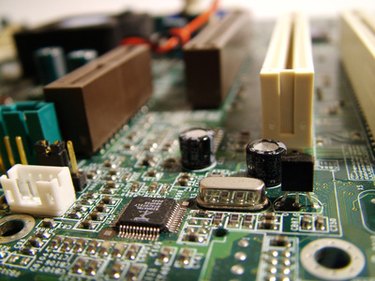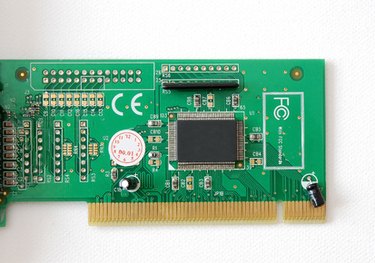
Even if you're not a technician or an engineer, some printed circuit board problems are obvious. Whether for a computer, home theatre system or other techno-gadget, some common and simple problems can cause a printed circuit board not to work. A thorough visual inspection of any problem circuit board could save you a trip to the repair shop or a needless inspection bill. Don't be afraid to have a look. Just make sure your power is turned off to make sure you don't get a jolt.
Step 1

Remove the cover from your equipment. Most electronic and computer covers are held on by four screws, two on each side near the bottom. Remove the screws with the screwdriver and set them aside. Lift the cover off.
Video of the Day
Step 2
Check to see if all the circuit boards (CB) are plugged in tightly. You may have only one, but if you have more, check them all. Many CB's have multi-pin edge connectors. Moving can cause them to work loose. Push the cards gently into their connecting slots to make sure they're plugged all the way in.
Step 3
Check individual plug-in components. Some chips, "daughter boards" or "piggy back" boards fit into their own sockets, and can have a loose connection. Pull them out and inspect them for dirty or corroded pins, and then reseat by pushing them gently in place so they are properly seated. The pins should be shiny and bright if they are clean and not corroded.
Step 4
Look for water or foreign objects anywhere on the circuit board. Sometimes a paper clip dropped onto a circuit board can stop it from working.
Step 5
Check secondary wiring plugs. Daughter boards and piggy-back boards may have a cable connection that just pushes on. Some of these can work loose in moving. Pull them off, inspect them for wear or corrosion and then replace them to ensure a snug fit.
Step 6

Look for blackened components or melted or broken parts of the printed circuit traces, the little metal lines that connect components together on both sides of the board. Components can burn out and when they do they can smoke. Also look for swollen or discolored components.
Step 7
Look for broken leads on the components. Some components have tiny wire leads that can easily break off right next to the circuit board or close to the component itself. Lightly jiggle larger components with wires to see if a wire might be broken.
Step 8
Look for cracks on the circuit board. A hairline crack may not look too damaging but it can include broken circuit traces.
Video of the Day